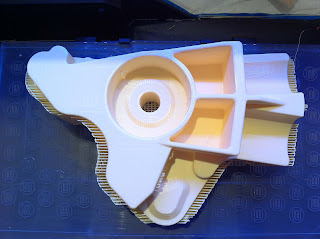Its been a while since the last update. Apologies for the gap but had to take care of the usually boring work that pays the bills. Hope you all had a good Christmas and New Year. Hopefully 2013 will be the year we finish up the first bike.
In anticipation of that goal, and the convienent timing of a friend having access to a low cost FDM prototyping machine, I am shifting focus to make some chassis parts. With a majority of the front end parts complete and the swingarm only needing a fixture to be welded on, completion of a rolling chassis is mostly being held up by lack of a chassis.
There’s a bunch of tubing, 3 billet parts, and a 4 castings. The tubes and billet parts are easily taken care of in my shop but the cast parts need to be outsourced. For the engine castings I contracted Harmony Castings, an experienced mold designer and fabricator to make the patterns as these were very complex parts with multiple cores. These chassis parts are much simpler parts with only a 2 piece mold needed. It is something I felt could be done in-house. As with all molding and casting operations the cost of the patterns is the lion’s share of the price. If I were able to make the patterns myself then the castings could be produced at a very reasonable cost.
The engine crankcases were made with a modified sand casting technique and cast in aluminum in keeping with the current best practices for engine crankcase production. These chassis parts will need to be in steel to be welded to the steel tube members. Since the parts are smaller and don’t have any coring needs I chose the investment casting process. This is one of the oldest metal casting techniques in existance and makes use of an expendable wax copy of the part and an expendable cermaic mold. The investment casting process has several advantages comapred to other casting processes:
- few geometry restrictions
- near net shape minimizes machining needs
- thin wall capability
- high casting tolerance
- high casting integrity
- high quality surface finish
The investment casting process is a multi step casting process that takes wax models of your parts which are then covered with a ceramic coating (the ‘investment’) that is then cured and fired to melt out the wax and produce a hollow ceramic shell of which the hollow internal volume is the part that you want to make. This hollow ceramic shell is then filled with metal, allowed to cool, and the ceramic shell broken away to reveal the final metal part. Investment casting is used extensively in jewlery making and many industries where small near net shape castings are needed. The first step is to have wax copies of your parts made with appropriate scaling to accomodate the various shrinkage ratios in each step. For making one part you can machine or carve a wax copy of the part you use but then since you have only one wax you only get one cast part. To get multiple parts you need some sort of mold to cast the wax to make multiple copies. If you have high volumes of parts you can make an aluminum mold that you inject the wax into. For the low to medium production volumes, where these parts are, there are some lower cost but still high quality options. The most common is to make a silicone mold around a scaled master copy of your part. The flexible silicone mold can easily accommodate no draft, undercuts and very small molding details. Since the silicone molding process is done at room temperature and pressure the master pattern does not need to be made from a strong material. It can be wood, foam, or…. plastic.
Enter David Celento, a fast 125 rider, architect of the highest caliber and all around great guy. I met Dave years ago at a USGPRU event at Jennings GP Raceway in Florida. Up to this point in my life I had never seen matching Grand Prix motorcycles painted in seafoam green.
Besides being bike color-challenged him not being too pissed that I had glancing contact with his wife on the track (she’s a 125 racer too!) convinced me he was a stand-up kind of guy. He and the missus drove from track to track with a beautiful Airstream trailer that we spent many a Saturday evening drinking wine and bench racing in. He now has access to a low cost rapid prototype machine that will enable us to create the patterns we need from an ABS-like plastic. The Makerbot rapid prototyping machine he has is in need of some dialing in and boy do I have some parts that can help out!
The Makerbot printer is one of the latest in a line of partial DIY rapid prototyping machines that have become quite competent if set up properly. For an approximately $2000 sale price the bang for the buck is very high.
If not set up properly they can make a mess.
But when the machine is properly set up the results are impressive:
Now that the machine is set up properly and making plastic parts the next step is to spray it with a few coats of filling primer, sand it all smooth, then spray it with a gloss clear coat to seal the surface with a very smooth finish. The part will be cast in silicone and any scratches or fill patterns will be accurately replicated in the silicone then the wax then the metal part, so in order to get a very smooth final part finsh we need a very smooth master surface finish. Peter will be helping me out with the sanding and painting process.
Once the parts get here I’ll post some pics of the finishing and silicone mold making process. I hope to have a productive few months ahead of me with the intent of having a rolling chassis ready by the beginning of August.
That’s it for now but more is coming soon.





Awesome! That's some very cool stuff. I've been wondering when a 3D printer will stumble into my household, and this draws an even clearer scenario. Being able to cast parts would be incredibly cool…
And it's always exciting to see an update on the Moto2 project!
Thanks! Initially I was skeptical about how good these $2k machines could be but after working through a couple of issues and seeing some parts am impressed with the results.
Good to see the project moving forward!
Hmm, have been thinking that a makerbot could be a cool way of making moulds for 'glass or carbon parts… but thanks for teaching me what "lost wax" casting is 🙂
A question though: for low volume, is it really more appropriate than just carving the parts out of a block of steel? Or was the pony just tired of that trick?
Glad to see it moving again, anyway 🙂
Like all rapid prototyping technologies it is great for getting a near net shape part easily and with no tooling or fixturing. For use as molds and patterns the same is true but there will need to be a decent amount of smoothing and finishing done to the parts before a mold can be made unless a coarse surface finish in the final cast part is acceptable. With the silicone mold/investment cating process being used the texture of the mold is very accurately reproduced in the cast parts. Time spent finishing the plastic pattern material to a high level is well spent because the resulting cast steel parts require a lot more effort to finish.
I could have carved them from a chunk of steel but did not for several reasons.
-The parts were designed as castings. There's a bunch of detail that would be hard to do in a machined part.
-Steel is a lot harder to machine and less forgiving than aluminum. Costs for cutting tools increase because you can't just hang an end mill out longer, it will chatter and dull quickly.
-The cost for chunks of 4130 that large is pretty high. The alternative of some plain carbon steel is also a couple of hundred dollars. With investment cating I am reducing cost of material by 90% over a 4130 block and am getting the material in a heat treat condition that matches the tubing.
-Even after spending all that time machining from billet you still have just one part. multiples are prohibitive for the reasons above. By doing a casting you are reducing machining time by 90%+ so make multiples that much easier and cheaper. this is destined to be a race bike and for a race bike there's nothing worse than a part you only have one of.
-I was able to get these rapid prototypes parts from a friend for free! He had to spend a couple of hours doing the import and support structure tweaking. An inexpensive machine did the majority of the work by running for dozens of hours unattended using a cheap raw material with no issues of crashing or breaking a tool or chips getting jammed or coolant getting clogged, etc. That is one of the huge benefits of these FDM style machines compared to a SLA or SLS. There is no laser diode to wear out or expensive resin that has a limited shelf life, just a brass nozzle, heater and plastic filament.
-There will need to be machining done to cast parts too but I designed the parts with that in mind and will need only one fixture per part to do all the necessary operations. To replicate this cast part in billet it would have required more effort for fixturing.
Its also nice to mix it up a bit. Investigating processes beyond my direct capabilities helps keep me up to date with recent developments and also helps me bring the most value to customer projects.
Thank you for the update! Very interested and following! 🙂